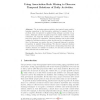Free Online Productivity Tools
i2Speak
i2Symbol
i2OCR
iTex2Img
iWeb2Print
iWeb2Shot
i2Type
iPdf2Split
iPdf2Merge
i2Bopomofo
i2Arabic
i2Style
i2Image
i2PDF
iLatex2Rtf
Sci2ools
ICOST
2011
Springer
2011
Springer
Using Association Rule Mining to Discover Temporal Relations of Daily Activities
The increasing aging population has inspired many machine learning researchers to find innovative solutions for assisted living. A problem often encountered in assisted living settings is activity recognition. Although activity recognition has been vastly studied by many researchers, the temporal features that constitute an activity usually have been ignored by researchers. Temporal features can provide useful insights for building predictive activity models and for recognizing activities. In this paper, we explore the use of temporal features for activity recognition in assisted living settings. We discover temporal relations such as order of activities, as well as their corresponding start time and duration features. To validate our method, we used four months of real data collected from a smart home.
| Added | 29 Aug 2011 |
| Updated | 29 Aug 2011 |
| Type | Journal |
| Year | 2011 |
| Where | ICOST |
| Authors | Ehsan Nazerfard, Parisa Rashidi, Diane J. Cook |
Comments (0)

